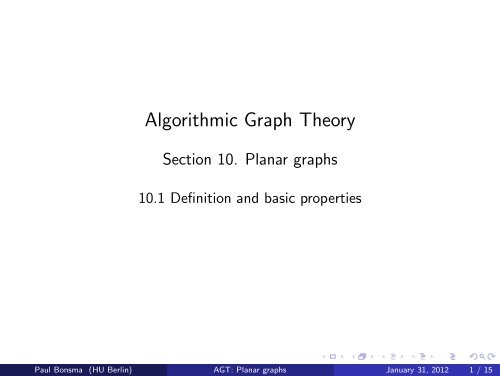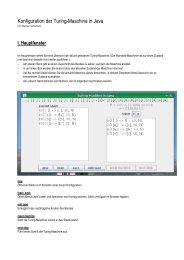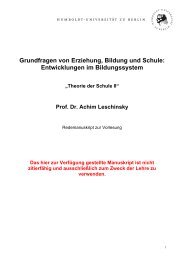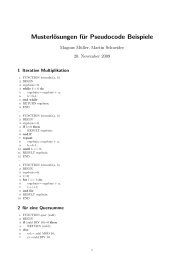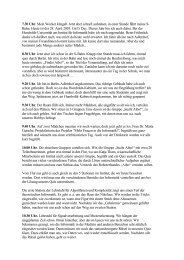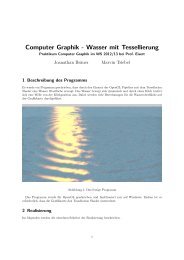Algorithmic Graph Theory: Planar Graphs
Algorithmic Graph Theory: Planar Graphs
Algorithmic Graph Theory: Planar Graphs
Create successful ePaper yourself
Turn your PDF publications into a flip-book with our unique Google optimized e-Paper software.
<strong>Algorithmic</strong> <strong>Graph</strong> <strong>Theory</strong><br />
Section 10. <strong>Planar</strong> graphs<br />
10.1 Definition and basic properties<br />
Paul Bonsma (HU Berlin) AGT: <strong>Planar</strong> graphs January 31, 2012 1 / 15
Introduction<br />
• Informally, a graph is planar if it can be drawn (embedded) in the plane<br />
such that two edges overlap only in common end vertices.<br />
• Topics in the next lectures:<br />
- <strong>Planar</strong> graphs and embeddings: basic properties<br />
- Encoding plane graphs / combinatorial embeddings<br />
- <strong>Planar</strong>ity testing and generating embeddings<br />
- Equivalence of embeddings and counting embeddings<br />
- Approximation algorithms on planar graphs<br />
- Dual graphs<br />
• <strong>Graph</strong>s in this section may be multigraphs.<br />
Paul Bonsma (HU Berlin) AGT: <strong>Planar</strong> graphs January 31, 2012 2 / 15
• Let X ⊆ R 2 be the union of all vertices and edges of an embedding φ.<br />
The regions of R 2 \X (maximal connected subsets) are called the faces.<br />
The (unique) unbounded face is called the outer face, the other faces<br />
inner faces.<br />
Paul Bonsma (HU Berlin) AGT: <strong>Planar</strong> graphs January 31, 2012 3 / 15<br />
Embeddings of graphs<br />
• A curve in the plane R 2 is the image of a continuous function<br />
f : [0,1] → R 2 .<br />
The ends are f(0) and f(1). The curve f is said to join f(0) and f(1).<br />
It is simple if for every a,b ∈ [0,1), f(a) ≠ f(b), and closed if f(0) = f(1).<br />
• A (planar) embedding φ of a graph G = (V,E) consists of an injective<br />
mapping φ : V → R 2 and a mapping φ of edges uv to simple curves in R 2<br />
that join φ(u) and φ(v), such that<br />
- for e,f ∈ E, φ(e)∩φ(f) contains only the images of common end<br />
vertices, and<br />
- for e ∈ E and v ∈ V, φ(v) ∉ φ(e).<br />
• Points φ(v) will also be called vertices, and curves φ(e) edges.
• A plane graph is a graph G together with an embedding φ of G.<br />
• A graph G is planar if it admits an embedding.<br />
• We will use basic topological facts without giving a rigorous<br />
introduction, e.g.:<br />
- A simple closed curve separates the plane into two regions (Jordan curve<br />
Theorem).<br />
Paul Bonsma (HU Berlin) AGT: <strong>Planar</strong> graphs January 31, 2012 4 / 15
Facial walks<br />
• Let f be a face of a plane graph (thus an open set). A vertex or edge is<br />
incident with f if it lies entirely in the closure of f.<br />
• The boundary of a face is the set of incident vertices and edges.<br />
• A closed walk W = v 0 ,e 0 ,v 1 ,e 1 ,...,e k−1 ,v k in G is called the facial<br />
walk corresponding to a face f if all vertices and edges of W are incident<br />
with f, and for all i ∈ {1,...,k}, e i mod k follows e i−1 in the clockwise<br />
order of edges around v i .<br />
• In a connected plane graph, for every face f there exists a facial walk<br />
that contains all vertices and edges incident with f. This facial walk is<br />
unique, up to the choice of v 0 and e 0 .<br />
• The degree d(f) of a face f is the length of its facial walk.<br />
Paul Bonsma (HU Berlin) AGT: <strong>Planar</strong> graphs January 31, 2012 5 / 15
• Let F be the set of faces of a plane graph with m edges. Then<br />
d(f) = 2m.<br />
∑<br />
f∈F<br />
• If a plane graph G has two faces with the same boundary, then G is a<br />
cycle.<br />
Paul Bonsma (HU Berlin) AGT: <strong>Planar</strong> graphs January 31, 2012 6 / 15
Proposition 10.1<br />
Let G, φ be a 2-connected plane graph without loops. Then every facial<br />
walk is a cycle.<br />
Proof: Suppose there exists a facial walk W = v 0 ,e 0 ,v 1 ,e 1 ,...,e k−1 ,v k<br />
that is not a cycle, so w.l.o.g. v 0 = v i for some 2 ≤ i ≤ k −2 (as G<br />
contains no loops). Let f be the face bounded by W.<br />
Then a simple closed curve can be drawn in f ∪φ(v 0 ), which separates v 1<br />
from v k−1 . So v 0 is a cut vertex, a contradiction. □<br />
Paul Bonsma (HU Berlin) AGT: <strong>Planar</strong> graphs January 31, 2012 7 / 15
Euler’s formula<br />
Proposition 10.2 (Euler’s Formula)<br />
Let G be a connected plane (multi-) graph with n vertices, m edges and k<br />
faces. Then n−m+k = 2.<br />
Proof: Induction over k. If k = 1, then G contains no cycles, so it is a<br />
tree, and thus m = n−1 and n−m+k = 2.<br />
If k ≥ 2, then G contains a cycle (!). Choose an edge e on a cycle. So e is<br />
incident with two distinct faces f 1 and f 2 .<br />
In G ′ = G −e, f 1 and f 2 become part of one face. So G ′ has k −1 faces,<br />
n vertices, and m−1 edges. By induction, n−(m −1)+(k −1) = 2, so<br />
n−m+k = 2.<br />
□<br />
• Note that the formula does not hold for disconnected graphs.<br />
Paul Bonsma (HU Berlin) AGT: <strong>Planar</strong> graphs January 31, 2012 8 / 15
• A plane graph is a triangulation if every face has degree 3.<br />
Proposition 10.3<br />
Let G be a simple plane graph with n ≥ 3 vertices and m edges. Then<br />
m ≤ 3n−6. If m = 3n−6, then G is a triangulation.<br />
Proof: We may assume that G is connected. Since G is simple, every face<br />
has degree at least 3.<br />
Let F be the set of faces, and k = |F|.<br />
Then 2m = ∑ f∈F d(f) ≥ 3k, so k ≤ 2 3m. Using Euler’s Formula,<br />
2 = n−m+k ≤ n− 1 3m, and thus m ≤ 3n−6.<br />
If m = 3n −6, then k = 2 3m, so every face has degree 3. □<br />
(Where did we use that n ≥ 3)<br />
Paul Bonsma (HU Berlin) AGT: <strong>Planar</strong> graphs January 31, 2012 9 / 15
• Proposition 10.3 has the following two corollaries:<br />
Corollary 10.4<br />
If G is a simple planar graph, then deg(G) ≤ 5.<br />
Corollary 10.5<br />
K 5 is not planar.<br />
Paul Bonsma (HU Berlin) AGT: <strong>Planar</strong> graphs January 31, 2012 10 / 15
Proposition 10.6<br />
Let G be a simple plane graph with n ≥ 3 vertices and m edges, in which<br />
every face has degree at least 4. Then m ≤ 2n−4. If m = 2n−4, then<br />
every face has degree 4.<br />
Proof: Similar.<br />
□<br />
Corollary 10.7<br />
If G is a simple planar bipartite graph, then deg(G) ≤ 3.<br />
Corollary 10.8<br />
K 3,3 is not planar.<br />
Paul Bonsma (HU Berlin) AGT: <strong>Planar</strong> graphs January 31, 2012 11 / 15
• We have seen that K 5 and K 3,3 are not planar. In fact, we will now see<br />
that every non-planar graph contains a subdivision of K 5 or K 3,3 (as a<br />
subgraph).<br />
• We will first prove this for 3-connected graphs. To that end, we need the<br />
following lemma.<br />
Paul Bonsma (HU Berlin) AGT: <strong>Planar</strong> graphs January 31, 2012 12 / 15
Lemma 10.9<br />
Let G be a 3-connected graph on at least 5 vertices. Then there exists an<br />
edge that can be contracted such that the resulting graph is again<br />
3-connected.<br />
Proof: Suppose to the contrary that for every edge xy, contracting xy<br />
yields a graph with connectivity 2. Then for every edge xy, there exists a<br />
vertex z such that {x,y,z} is a vertex cut. Choose edge xy and z such<br />
that the number of vertices of the largest component C 1 of G −x −y −z<br />
is maximized.<br />
Let C 2 be another component of G −x −y −z, and choose a neighbor<br />
u ∈ V(C 2 ) of z (exists, since G 3-connected). Then there exists again a<br />
v ∈ V(G) such that {u,v,z} is a vertex cut. Consider<br />
G ′ = G[(V(C 1 )∪{x,y})\{v}]. Note that G ′ is connected. Therefore it<br />
is a subgraph of a component of G −u −v −z, larger than C 1 ,<br />
contradicting the choice of xy.<br />
□<br />
Paul Bonsma (HU Berlin) AGT: <strong>Planar</strong> graphs January 31, 2012 13 / 15
• An embedding of a graph is convex if every inner face is convex.<br />
• An embedding of a graph is a straight line embedding if every edge is a<br />
line segment.<br />
Theorem 10.10<br />
Let G be a 3-connected simple graph that contains no subdivision of K 5 or<br />
K 3,3 . Then G admits a convex straight line embedding.<br />
Proof: Induction over n = |V(G)|. The cases n ∈ {4,5} are easy, so<br />
assume n ≥ 6.<br />
By Lemma 10.9, G contains an edge xy that can be contracted into a<br />
vertex z without destroying 3-connectedness. Let the resulting (simple)<br />
graph be G ′ .<br />
If G ′ would contain a subdivision of K 5 or K 3,3 , then this holds for G as<br />
well (why!). So by induction, G ′ admits a convex straight line<br />
embedding. This yields a straight line embedding of G −y as well.<br />
The graph G ′ −z is 2-connected. So the face of G ′ −z that contains z is<br />
bounded by a cycle C (Proposition 10.1).<br />
Paul Bonsma (HU Berlin) AGT: <strong>Planar</strong> graphs January 31, 2012 14 / 15
Proof, continued: Let x 0 ,...,x k−1 be the neighbors of x on C, in order<br />
along the cycle (k ≥ 2). Let P i be the subpath from x i to x i+1 mod k .<br />
• If all vertices in N(y)\{x} lie on one path P i , then y can be drawn in<br />
the face incident with P i and x, to obtain the desired embedding of G.<br />
Note that it can be made convex.<br />
• If y has at least three neighbors in {x 0 ,...,x k }, then a subdivision of K 5<br />
is found.<br />
• Otherwise, w.l.o.g. one neighbor a of y is an internal vertex of P 0 , and y<br />
has at least one neighbor b not on P 0 . Then a subdivision of K 3,3 can be<br />
exhibited (with “bipartition” {a,b,x},{x 0 ,x 1 ,y}). □<br />
Q: Do 2-connected simple graphs always admit a convex embedding<br />
A: No, but they do admit a straight line embedding.<br />
Paul Bonsma (HU Berlin) AGT: <strong>Planar</strong> graphs January 31, 2012 15 / 15


